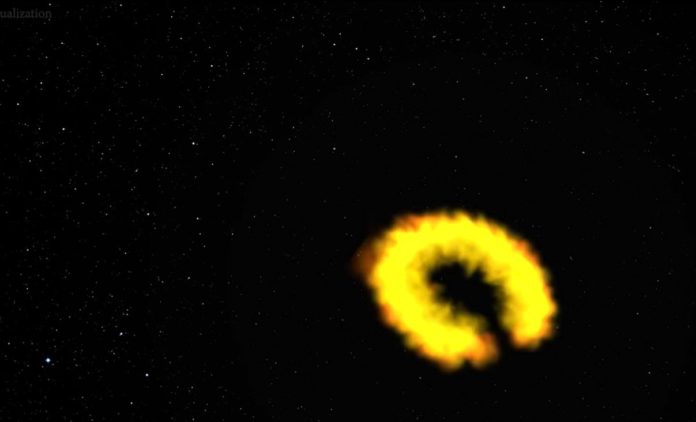A black hole at the center of the dwarf galaxy Henize 2-10 is producing stars rather than devouring them.
The black hole appears to be contributing to the galaxy’s current inferno of new star creation. The dwarf galaxy is located in the southern constellation Pyxis, 30 million light-years away.
A decade ago, this little galaxy sparked a dispute among astronomers about whether dwarf galaxies harbored black holes comparable to the supermassive behemoths detected in the centers of larger galaxies. This new discovery positions little Henize 2-10, which has only a tenth of the stars contained in our Milky Way, to play a significant role in resolving the enigma of how supermassive black holes formed in the first place.
“Ten years ago, as a graduate student thinking I would spend my career on star formation, I looked at the data from Henize 2-10 and everything changed,” says Amy Reines, who published the first evidence for a galaxy-wide black hole in 2011 and is the principal investigator on the new Hubble observations published in the January 19 issue of Nature.
“From the beginning I knew something unusual and special was happening in Henize 2-10, and now Hubble has provided a very clear picture of the connection between the black hole and a neighboring star forming region located 230 light-years from the black hole.”
That link is a gas outflow from a brilliant star nursery that stretches across space like an umbilical cord. When the low-velocity outflow came, the region already had a dense cocoon of gas. According to Hubble spectroscopy, the outflow was travelling at around 1 million miles per hour, striking against the dense gas and spreading out like a garden hose hitting a pile of dirt. Newborn star clusters dot the course of the outflow’s propagation, with Hubble calculating their ages as well.
This is the polar opposite of what happens in larger galaxies, where material falling toward the black hole is swept away by the surrounding magnetic fields, resulting in scorching jets of plasma flying at near-light speed. Gas clouds caught in the path of the jets would be heated to the point where they couldn’t cool down and create stars. However, with the less-massive black hole in Henize 2-10 and its softer outflow, gas was compressed just enough to initiate the birth of new stars.
“At only 30 million light-years away, Henize 2-10 is close enough that Hubble was able to capture both images and spectroscopic evidence of a black hole outflow very clearly. The additional surprise was that, rather than suppressing star formation, the outflow was triggering the birth of new stars,” adds Zachary Schutte, lead author of the new study.
Ever since her first finding of distinctive radio and X-ray emissions in Henize 2-10, Reines has assumed they likely emanated from a huge black hole, but not as supermassive as those discovered in larger galaxies. Other astronomers, on the other hand, believed the radiation was coming from a supernova remnant, which would be a common event in a galaxy that is fast producing enormous stars that explode.
“Hubble’s amazing resolution clearly shows a corkscrew-like pattern in the velocities of the gas, which we can fit to the model of a precessing, or wobbling, outflow from a black hole. A supernova remnant would not have that pattern, and so it is effectively our smoking-gun proof that this is a black hole,” Reines says.
Dwarf galaxy black holes, according to Reines, will be the subject of even more investigation in the future, with the goal of using them as clues to the puzzle of how supermassive black holes formed in the early cosmos. Astronomers have been pondering this question for a long time. The link between the galaxy’s mass and its black hole can reveal information. Henize 2-10’s black hole has a mass of about a million solar masses. Black holes in larger galaxies can be more than a billion times the mass of our Sun. The core black hole grows in size as the host galaxy grows in size.
There are three types of current theories about the origin of supermassive black holes: 1) they arose from the implosion of stars, just like smaller stellar-mass black holes, and managed to gather enough material to sprout supermassive, 2) special conditions in the early universe allowed for the formation of supermassive stars, which collapsed to form massive black hole “seeds” right away, or 3) the seeds of future supermassive black holes were born in dense star clusters, where the cluster’s overall mass would have been enough to create them from gravitational collapse.
So far, none of these black hole seeding hypotheses has emerged as the most compelling. Because dwarf galaxies, such as Henize 2-10, have remained small across cosmic time rather than growing and merging like the Milky Way, they offer promising prospective clues. Dwarf galaxy black holes, according to astronomers, could represent analogs for black holes in the early universe, when they were only starting to form and grow.
“The era of the first black holes is not something that we have been able to see, so it really has become the big question: where did they come from? Dwarf galaxies may retain some memory of the black hole seeding scenario that has otherwise been lost to time and space,” Reines adds.
Image Credit: NASA
You were reading: Hubble discovers a black hole that creates rather than absorbs stars
